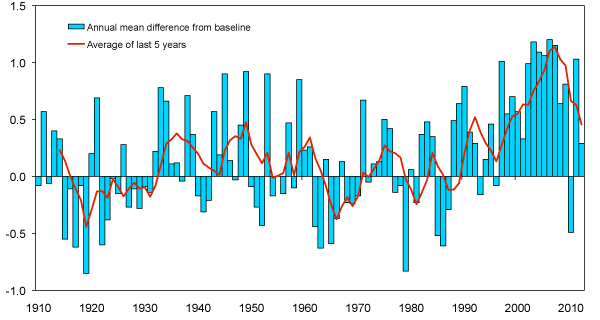Key Scottish Environment Statistics 2013
This publication aims to provide an easily accessible reference document which offers information on a wide range of environmental topics. It covers key datasets on the state of the environment in Scotland, with an emphasis on the trends over time wherever possible. The data are supplemented by text providing brief background information on environmental impacts, relevant legislation and performance against national and international targets.
Annual Mean Temperature: 1910-2012
Annual mean temperature - difference from 1961-1990 average (degrees Celsius)1

The balance between incoming solar energy and outgoing infrared radiation determines the Earth's temperature. Changes in the amount of energy retained within the atmosphere affects global climate, which naturally exhibits long-term fluctuations. Current climate trends are unlikely to be entirely natural in origin, however, and there is now evidence that human activities are having a discernible impact on the global climate.2
Whilst the global impacts of climate change are considerable, there are also wide-ranging implications for Scotland. Flood risk, water resources, agriculture, tourism and health may be affected, all of economic, social and environmental importance.
Over the period 1901-2000, the increase in mean global surface temperature, explained by a linear trend, is 0.57 degrees Celsius (°C).3 Similarly, a linear trend through the Scottish temperature series for the period 1910-2010 indicates an average annual increase of 0.006°C, or 0.6°C each 100 years.4
The temperatures between 2003 and 2007 in Scotland were the highest since the record began in 1910. The average temperature in the 2000s was 0.90°C higher than the 1961-1990 average and warmer than any other decade. 2012 shows a decrease in mean temperature of 0.74°C compared with 2011. The 2012 temperature of 7.32°C is 0.29°C higher than the 1961-1990 average.
Temperatures in Scotland are projected to continue increasing over the next century, with hotter summers and milder winters. For example, by the 2080s, projected increases5 in mean temperature for Scotland East in winter months6 is 2.2°C (1.0°C to 3.7°C) and in the summer months7 is 3.5°C (1.8°C to 5.7°C).
Source: Met Office / Metadata
Contact
Email: Callum Neil
There is a problem
Thanks for your feedback